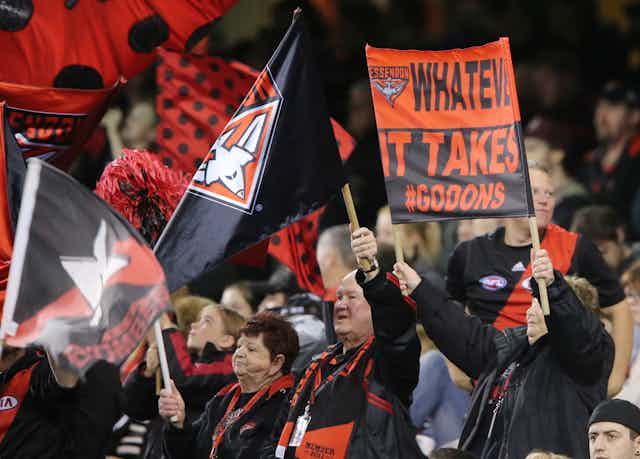The notice of charges by the AFL against Essendon Football Club has been published, and we have dealt elsewhere with some of the facts of the matter. But some harder questions remain. What does this list represent? Why is it the way it is?
Should the allegations prove to be true as stated, the “supplement program” at Essendon was a shambolic laundry list of legal, quasi-legal and totally illegal substances, obtained openly or covertly, that range between somewhat effective and laughable in efficacy. Nothing on the list, to my knowledge, has both:
- evidence of its effectiveness over and above an equivalent placebo
- undergone clinical trials that show minimal harm
The lesser known “peptides” on the list were either pulled from clinical trials or have not been tested in humans in any relevant context.
It seems, therefore, an extraordinarily cavalier idea that professional sports players would be subjected to doping protocols that combine these and other supplements in a dosing protocol determined, seemingly, by dead reckoning.
And this in an environment in which training, food, game strategy, recovery, and the like are usually very carefully planned. How could this possibly be the case?
A series of factors might make such a regime seem like a good idea, so let’s tackle these one by one:
1) What defines ‘unnatural’?
The general will and means for athletes to attempt to modify their bodies is huge. So often overlooked is the fact that professional sport is already a series of extremely unnatural distinctions: an AFL player, for instance, may have perfectly legal cortisone injections, a knee made out of pieces of his hamstring, artificially reconstructed bones, and so on.

He may take a series of “supplements” that are legal but not considered drugs, or a series of drugs that are only appropriate when prescribed. This list is in continual flux, depending mainly on the efficacy of the substances used.
He may train at altitude, artificially restrict or enhance his oxygen intake, his use of ice or contrast baths, use electromuscular stimulation to recover from training, and if injured may receive the most extraordinarily aggressive rehabilitation, sometimes starting only hours after surgery. The list goes on.
This is already a very unnatural environment - and in it, banned substances often appear to be just another method of achieving the same end. What is the “right” and “wrong” way to achieve a training effect changes radically over time.
2) Anything you can do
There’s a sense of fear pervading the implementation of the alleged program: the idea that someone, somewhere in the competition, might have an edge. The program is alleged to have been set up and implemented extremely quickly. Then-Essendon sports scientist Steven Dank sent a text message on December 1, 2011:
Collingwood is on TA65
… then another later that day that said:
I am planning […] at the moment. We are planning something better.
To any observer of professional athletics, this kind of “arms race” mentality is immediately familiar.
There are good historical records of the different eras of doping in sport, and how the competition caught up. Coaches and performance directors are always on the look-out for new techniques although, due to the willingness to adopt unproven methodology early enough to “get a head-start” on the competition, this can often result in the use and endorsement of various forms of snake oil.
3) Self-medication
A curious detail: one of the disputed allegations is that high-performance coach Dean Robinson provided coach James Hird with Melanotan II - a drug which is unapproved for human use and causes melanogenesis (or tanning) and a range of side-effects.
The section in the report describing Hird suffering side-effects is redacted - which may have something to do with the fact that Melanotan-II produces spontaneous erections.
It’s also alleged that Dank later provided Hird with propanolol and ephedrine. Propanolol is a beta-blocker - it antagonises the transmission within the sympathetic nervous system. It’s commonly used by people who need to maintain focus and control under tension (classical musicians, for instance, or rifle/pistol/trap shooters) as it prevents the “feedback loop” that you get during performance anxiety.

Ephedrine is roughly the opposite, a sympathomimetic stimulant described in the document as “mild”. I would take issue with this - it is most assuredly not mild in the correct dosage. It was used as a weight-loss supplement in the US for years, but was removed from sale in 2004 due to both abuse potential and the fact it’s exceptionally useful as a precursor to manufacture amphetamines.
The relevance of the above is interesting - if the allegation is true (and Hird has vehemently denied several key allegations in the AFL document, including that he used Melanotan II) then Hird’s attitude towards modifying his own biochemistry would seem clear. Certainly it would be easier to imagine the state of mind that would approve a club-wide “supplementation” program.
4) (Un)Informed Consent
The last issue here is one of informed consent. One of the most disturbing allegations describes the decision to label the administered peptides as “amino acids or something”.
Later, players are said to have signed waivers to participate in the program, but even this might not constitute a fair appraisal of risks - consent, yes, but not very well informed!
Only a research scientist or doctor with an intimate familiarity of sports doping could be presented with the name of a drug on a legal document and know the benefits or risks of the substances involved.
Certainly, had an external doctor with a modicum of ethics been consulted on the alleged “supplement program”, he or she would have raised an enormous red flag more or less immediately.
When the above factors are collected, it seems clearer as to why these allegations are the way they are.
None of it, however, makes it a particularly good idea.

